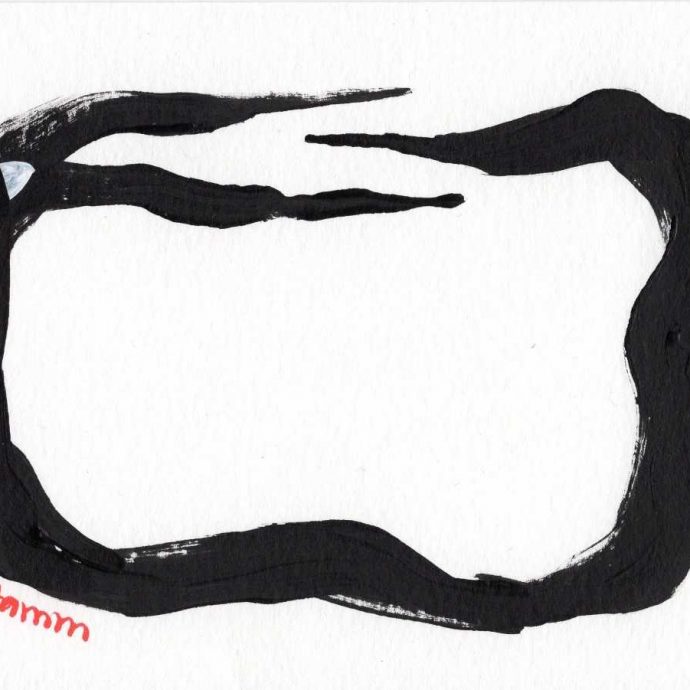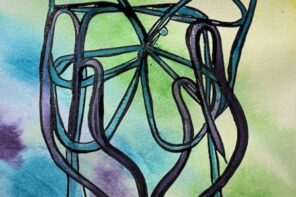Kelly Link is the author of the collections Stranger Things Happen, Magic for Beginners, Pretty Monsters, and most recently, the 2016 Pulitzer Prize Finalist, Get In Trouble. She has co-edited several anthologies, including The Years Best Fantasy and Horror, is the co-founder of Small Beer Press, and co-edits the zine Lady Churchill’s Rosebud Wristlet. Her stories have a way of inviting the impossible inside, of guiding things strange and slippery to the very place in the room where they can find their light.
Kelly and I met on a warm afternoon for lunch on a quiet stub of street, where we discussed writing with friends, queer tragic love stories, and the truth about short cuts.
Red Samaniego: I’m wondering, when you’re writing, are there ideas, activities or people that you feel you’re in conversation with during that process? What forces act upon your work as you write?
Kelly Link: Usually when I’m writing there are at least two other people at the table writing with me, the writers Holly Black and Cassandra Clare. Sometimes there are seven or eight other writers. In the grand scheme of things most writers prefer to work in isolation, but I’ve found I get great energy from being part of a working community with people who are like, “Writing is a thing we all do, there’s no reason we can’t sit all at the table and talk about it as we do it!” Occasionally we will have a formal workshop where someone’s finished a final draft and we talk about it, but mostly we’re talking intermittently as we work.
RS: So, what sorts of questions might you bounce off your collaborators, or co-workers, then?
KL: Oftentimes what we’re checking is to see if an effect that we wish to produce in the reader is present. Sometimes the question is very basic, maybe “I feel that this scene or description or pace is not working, but I don’t understand why,” which is a thing that all writers feel. By helping other writers think through certain kinds of approaches to their work, and by listening, my own understanding of what I want to do in my work is enriched and usefully complicated.
I think normally if you’re working on your own you think, “I have this intuition about the work that I’m doing and I’m going to sit with it until I can formulate a reason for that,” but because we’re all working in the same space, if we have that intuition we just pass a laptop to someone else and say, will you take a look at this? Does this feel right to you? And the person will say, “This part is obscure,” or “I don’t understand something that I think I need to understand in order to feel what you want me to feel.” Then you take that information and turn it over and see if it’s helpful.
I think what it requires is a sense of trust—that they are giving you honest feedback and that they have some idea of what you’re trying to do in your writing. This is a working method that we’ve evolved over time, and I’ve been fortunate enough throughout my working life to be in proximity with writers where that trust was present from the start.
RS: What you’re saying about passing the laptop back and forth makes me wonder about the role of destabilization. I’m thinking of the beginning of your story “Two Houses” or the “Valley of the Girls,” where the complete scenario is not explained at first and there’s a time-warp feeling or the feeling of falling into a wormhole, and I’m interested in your thoughts on destabilizing the reader. How do you know when to clarify?
KL: With narrative, especially with short stories, the space is compact. Once you begin thinking about components like character and milieu and the action of what’s going to happen, you have to start making decisions: What do you need to introduce first? What slows down the pacing? What is it that, when withheld, makes other parts become less accessible? All writing is this weird mapping out of what’s in your head, but you have to figure out sequentially what it is you have to show people or how to lead them along to figure things out. For me, the thing that enables me to make other decisions is structure. Structure and tone. What feeling do I wish to evoke, and what rules do I wish to set myself?
There’s a writer, Howard Waldrop, who says that all writers, no matter when they are setting their story, have a personal timeframe; often childhood or adolescence or a moment in life which was traumatic or emotionally full of wonder, and so, and often when they write they draw on this landscape, those feelings, that moment in time, in order to frame how people interact, even if they’re setting stuff in the future or the past. What you want is for something to feel lived in.
Fantasy—secondary world fantasy in the vein of Ursula K. Le Guin, or epic fantasy like the kind that George R. R. Martin writes—has that same informational challenge. So does science fiction. And because I don’t have a background in history or anthropology or science, if I work in secondary world fantasy or in historical stuff, I feel like I’m performing pastiche. I can aim in the direction of it, but I am trying on some clothes rather than entirely making something out of myself and what I know. If I write in the genre of science fiction, I am queasily aware that my fiction is less well-informed than the work of someone like, say, Kim Stanley Robinson or Ted Chiang.
RS: Often when I read fiction set outside of the real world I think, well, this monster is starting to feel like it’s interacting with a racial stereotype, or this cult is starting to feel like it’s making fun of a real religion. I’m wondering if you could speak about the strategies you use to walk that line: bringing in imaginative material while keeping out what you don’t want to perpetuate.
KL: Yeah, so the other night [at the Washington University in St. Louis Hurst Reading] I talked about seeking out the work and genres which are pleasurable to you, and when you’re a writer and you’re drawing from those sources, one of things that entails is thinking closely about what’s drawing you.
Genre’s strength is that the patterns genre depends on are sturdy ones. Because of this, they have great staying power. Also because of this, the patterns are conservative. They tap into symbols and correlations that come out of cultural consensus. When writers organize stories around patterns, especially when there’s a death, or a danger, or a bad person, there will inevitably be a metaphor at work. Especially in horror, which is organized around what an individual or society is afraid of, or the patterns of behavior that a family or country or community sees as concerning, it’s hard work to negotiate the metaphor with nuance. Horror leans toward the threat of the other and the punishment of people who break taboos. The default poles of horror are that either there are things that we shouldn’t attempt to understand, or else it asks us to understand in terrible detail what we don’t wish to understand. It locates blame, and it relies heavily on emotions like disgust, discomfort, dis-ease, etc.
So then the question is, what is your approach? I was on a panel with a bunch of writers where the topic was monsters. Sofia Samatar asked everyone to talk about their personal favorite monsters; she said she loves ogres and orcs. And I thought, she can explore that in productive ways that I cannot.
The question of representation and “who gets to write what” is something I think about all the time. I am a white woman of a certain age and class with a certain kind of life experience. I draw from what my life has been. And yet, if I want to reproduce the world around me, that world includes people who are not like me, who are as complicated and three-dimensional and central as I am. And then, if you’re writing in genre territory as I am, then you have the complications of those patterns and those interactions of how the real maps onto the invented. Writers have to spend time thinking about these questions and interactions—not in order to arrive at a definitive answer, but as a process that continues. You must keep asking the question and hearing how other writers and people are thinking about it. You ask the questions every time you sit down to work on a new project and at every stage of revision. You ask the question as genre, slowly, evolves and as cultural shifts occur. There are many books which pushed the envelope when they were published in terms of representation, but now they feel dated or uncomfortable because the culture has moved on.
I have a friend who writes historical young adult fantasy and the words and categories that were relevant in past times have changed. How do you manage that disconnect between how a person once thought about themselves in private, and the vocabulary they used, versus how the same person claiming the same identity now would think of themselves? If the culture and time that they lived in would not let this person be themselves, how can you make their story larger than simply the narrative in which they make a space for themselves to live as they choose? Can you give them an adventurous, swashbuckling narrative as exciting as the one you’d give a character who, in that time and place, would have been allowed to be themselves? What is the value of escapism versus representation of pain or repression? You have to ask, what am I saying here? What are the patterns I’m reproducing? Is there a tragic ending for this character? If a queer character dies, how does it re-enforce patterns in fiction or narrative?
I see writers online say, “If I’m a queer writer, I should be able to write a tragic queer love story if I wish to,” and yeah, absolutely. But then the question for the straight writer is, should you write a tragic queer love story? That’s something you need to think about. In the community of writers that I am closest to, we think about this and talk this over constantly.
RS: One place I noticed a thoughtful approach to difference and cultural patterns would be in your story “The Lesson.” A gay couple is going to have a baby and the supernatural is not involved in this aspect of the story. The story refuses to reproduce a pattern of representing gay families as unnatural.
KL: I’d had the idea for the story for a very long time. I always envisioned it as one where, in the end, a person arrives late on the island and is a very ominous figure. There’s this ominous figure arriving but there’s also a baby arriving and there’s a lot of unease around the pregnancy. It would be absolutely conservative and, to me, wrong to suggest that there was an uncanniness to the situation other than the general uncanniness of babies and pregnancy. If the couple had been straight there might have been more freedom to make the baby monstrous, because the metaphor would be more clearly “are children human or monstrous?” That’s a perfectly fine and flexible metaphor. It says something about the mind of a parent.
Making decisions about identity means shutting down certain story possibilities, but that’s true of every story: you make a series of decisions and you shut doors and you proceed along a narrowing path. At least that’s how I arrive at my endings, there’s a movement toward a very specific place. The decision to close off the monstrous baby story possibilities meant that I could locate monstrousness in more surprising areas.
RS: That process makes writing so valuable for me, those moments when I think, “Oh, where did that come from?” and realize it’s a cultural idea or a habit of thinking that really told me a lot about myself, and that now I have the freedom to go back and alter it, engage it, dismiss it.
KL: I watched the movie The Ritual with friends recently, and there was a mundane scene at the beginning where the characters leave a pub and two go into a grocery store. At which point, I looked to my friend and said, that guy’s going to die isn’t he? I couldn’t tell you specifically what in the narrative structure indicated that the character was going to die, but narrative and genre interact in ways that, when it’s the kind of work that you yourself are engaged in, it’s like looking at an x-ray. You see the markers and shape of something cloudy and the likelihood of certain outcomes.
RS: How exciting to think that, in your mind, you’ve identified some signposts, but there are always so many more flying under your radar!
KL: Yes! And when I watch horror I think, “Why is watching people make a series of incremental somewhat-terrible decisions so pleasurable?” In this movie, the hikers decide to take a shortcut, and when they did that my friend said “My grandmother always said, if a shortcut was really a shortcut it wouldn’t be called a shortcut. It would be just be a path.” And that got me thinking about the idea of a shortcut and why it seems so full of narrative possibility, how when someone says shortcut you really think, well, there’s narrative risk there.
RS: I also want to ask you about names in your stories because I love them—Bunnatine, Fast Kid With Secret Money, the Demon lover—and I wondered if you could share some naming strategies or inspirations.
KL: So Bunnatine was an actual whistle blower, and we are currently living through an era of heroic whistleblowers. I wanted to give some of that heroic-ness to my character. More generally, in short stories, everything has to work on more than one level because of compression and names are a way to obliquely signal something that you’re not going to tell the reader otherwise, or to contradict something you’re doing with the character. They’re also a way to organize something that I don’t necessarily know about the character. I can’t get far into a story about someone if I don’t have a name for that person that feels right. Fast Kid with Secret Money was something that a friend of mine was called at his local convenience store. I asked him if I could use that nickname.
RS: If you have a character’s name and you’ve started to envision what they’re like, does it ever happen that the character won’t fit into the world you’ve built for them?
KL: Sometimes I’ve picked a name because it’s the name of a character in a book a lot of people know, and I want to borrow directly from something that that book or writer does. Sometimes I want to write in an entirely different genre but have that writer or book or character in the back of the reader’s head anyway. When you’ve inserted something in the story that’s at odds with the direction you see the story going in, the question is, is it productive? What does it mean that you’re wanting two things that are pulling in opposite directions? Investigate! How does the story change because of the strange thing you’ve done to it? Or, on the other hand, are you attached to something that you shouldn’t be? And if so, why?
Allow yourself places and space in your work to do thing that you want to do even you don’t understand why you want to do them. And then, if they seem worth keeping, even if you can’t articulate why they are important to you, develop the writerly tools that will allow you to keep the material that seems most lively and strange and emotionally connected to you. A useful question when writing is always, “What is the thing that you want to do so badly in a story or with a character or a narrative shape that you are willing to do or undo all this other work so you can keep that thing?” There should be something present in the story that matters to you so much that you’ll rearrange everything else to make that one thing successful.
When I write, it’s because I really want to know what happens if I work from a certain approach or in a certain kind of structure. But I am also trying to make what’s at the heart of the story clear to myself early on. Where is the emotional center? What is the question that I’m asking, and why does it matter to me?
RS: Do you ever find out, through the course of writing a story, that the question or thing you wanted to explore doesn’t work?
KL: No, because I’m really stubborn, and often the thing I’m interested in is a pattern or an emotional affect, [such as] figuring out how to rework a pattern. And because I almost always know what the ending is before I start a story, I think that if you work in a determined way toward a specific ending with a specific emotional tone, you’ll make it work. Here’s the thing about endings and revision. Conventional wisdom is that the original ending is too easy or expected, so push it to a second ending, then abandon that second ending, and come up with a third. The third ending is one the readers won’t predict. It’s going to be interesting, it will have moved into a genuine space. You will have stepped out of conventional patterns and toward something that belongs more completely to you. But I think because I start with the ending, I think that what I’m doing is attempting to navigate in a direction that doesn’t look like it will lead to the ending I have in mind. Many people spend a lot of time reworking their endings to get to that second or third ending, but I spend a lot of time reworking my beginnings.
Red Samaniego is a fiction writer still finding their light. They are an intern at Dorothy, a publishing project, and founder of The MFA App Review.




